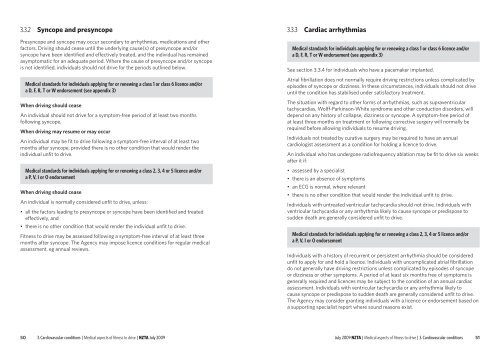Medical aspects of fitness to drive a guide for medical practitioners
Medical aspects of fitness to drive a guide for medical practitioners
Medical aspects of fitness to drive a guide for medical practitioners
Create successful ePaper yourself
Turn your PDF publications into a flip-book with our unique Google optimized e-Paper software.
3.3.2<br />
Syncope and presyncope<br />
3.3.3<br />
Cardiac arrhythmias<br />
Presyncope and syncope may occur secondary <strong>to</strong> arrhythmias, medications and other<br />
fac<strong>to</strong>rs. Driving should cease until the underlying cause(s) <strong>of</strong> presyncope and/or<br />
syncope have been identified and effectively treated, and the individual has remained<br />
asymp<strong>to</strong>matic <strong>for</strong> an adequate period. Where the cause <strong>of</strong> presyncope and/or syncope<br />
is not identified, individuals should not <strong>drive</strong> <strong>for</strong> the periods outlined below.<br />
<strong>Medical</strong> standards <strong>for</strong> individuals applying <strong>for</strong> or renewing a class 1 or class 6 licence and/or<br />
a D, F, R, T or W endorsement (see appendix 3)<br />
When driving should cease<br />
An individual should not <strong>drive</strong> <strong>for</strong> a symp<strong>to</strong>m‐free period <strong>of</strong> at least two months<br />
following syncope.<br />
When driving may resume or may occur<br />
An individual may be fit <strong>to</strong> <strong>drive</strong> following a symp<strong>to</strong>m‐free interval <strong>of</strong> at least two<br />
months after syncope, provided there is no other condition that would render the<br />
individual unfit <strong>to</strong> <strong>drive</strong>.<br />
<strong>Medical</strong> standards <strong>for</strong> individuals applying <strong>for</strong> or renewing a class 2, 3, 4 or 5 licence and/or<br />
a P, V, I or O endorsement<br />
When driving should cease<br />
An individual is normally considered unfit <strong>to</strong> <strong>drive</strong>, unless:<br />
• all the fac<strong>to</strong>rs leading <strong>to</strong> presyncope or syncope have been identified and treated<br />
effectively, and<br />
• there is no other condition that would render the individual unfit <strong>to</strong> <strong>drive</strong>.<br />
Fitness <strong>to</strong> <strong>drive</strong> may be assessed following a symp<strong>to</strong>m‐free interval <strong>of</strong> at least three<br />
months after syncope. The Agency may impose licence conditions <strong>for</strong> regular <strong>medical</strong><br />
assessment, eg annual reviews.<br />
<strong>Medical</strong> standards <strong>for</strong> individuals applying <strong>for</strong> or renewing a class 1 or class 6 licence and/or<br />
a D, F, R, T or W endorsement (see appendix 3)<br />
See section 3.3.4 <strong>for</strong> individuals who have a pacemaker implanted.<br />
Atrial fibrillation does not normally require driving restrictions unless complicated by<br />
episodes <strong>of</strong> syncope or dizziness. In these circumstances, individuals should not <strong>drive</strong><br />
until the condition has stabilised under satisfac<strong>to</strong>ry treatment.<br />
The situation with regard <strong>to</strong> other <strong>for</strong>ms <strong>of</strong> arrhythmias, such as supraventricular<br />
tachycardias, Wolff‐Parkinson‐White syndrome and other conduction disorders, will<br />
depend on any his<strong>to</strong>ry <strong>of</strong> collapse, dizziness or syncope. A symp<strong>to</strong>m‐free period <strong>of</strong><br />
at least three months on treatment or following corrective surgery will normally be<br />
required be<strong>for</strong>e allowing individuals <strong>to</strong> resume driving.<br />
Individuals not treated by curative surgery may be required <strong>to</strong> have an annual<br />
cardiologist assessment as a condition <strong>for</strong> holding a licence <strong>to</strong> <strong>drive</strong>.<br />
An individual who has undergone radi<strong>of</strong>requency ablation may be fit <strong>to</strong> <strong>drive</strong> six weeks<br />
after it if:<br />
• assessed by a specialist<br />
• there is an absence <strong>of</strong> symp<strong>to</strong>ms<br />
• an ECG is normal, where relevant<br />
• there is no other condition that would render the individual unfit <strong>to</strong> <strong>drive</strong>.<br />
Individuals with untreated ventricular tachycardia should not <strong>drive</strong>. Individuals with<br />
ventricular tachycardia or any arrhythmia likely <strong>to</strong> cause syncope or predispose <strong>to</strong><br />
sudden death are generally considered unfit <strong>to</strong> <strong>drive</strong>.<br />
<strong>Medical</strong> standards <strong>for</strong> individuals applying <strong>for</strong> or renewing a class 2, 3, 4 or 5 licence and/or<br />
a P, V, I or O endorsement<br />
Individuals with a his<strong>to</strong>ry <strong>of</strong> recurrent or persistent arrhythmia should be considered<br />
unfit <strong>to</strong> apply <strong>for</strong> and hold a licence. Individuals with uncomplicated atrial fibrillation<br />
do not generally have driving restrictions unless complicated by episodes <strong>of</strong> syncope<br />
or dizziness or other symp<strong>to</strong>ms. A period <strong>of</strong> at least six months free <strong>of</strong> symp<strong>to</strong>ms is<br />
generally required and licences may be subject <strong>to</strong> the condition <strong>of</strong> an annual cardiac<br />
assessment. Individuals with ventricular tachycardia or any arrhythmia likely <strong>to</strong><br />
cause syncope or predispose <strong>to</strong> sudden death are generally considered unfit <strong>to</strong> <strong>drive</strong>.<br />
The Agency may consider granting individuals with a licence or endorsement based on<br />
a supporting specialist report where sound reasons exist.<br />
50 3. Cardiovascular conditions | <strong>Medical</strong> <strong>aspects</strong> <strong>of</strong> <strong>fitness</strong> <strong>to</strong> <strong>drive</strong> | NZTA July 2009<br />
July 2009 NZTA | <strong>Medical</strong> <strong>aspects</strong> <strong>of</strong> <strong>fitness</strong> <strong>to</strong> <strong>drive</strong> | 3. Cardiovascular conditions 51
















